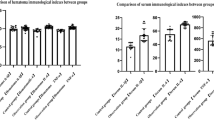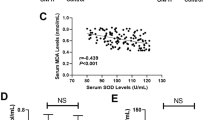Abstract
Bone fracture healing is a complex process which at best results in full recovery of function and structure of injured bone tissue, but all the mechanisms involved in this process, and their mutual interaction, are not fully understood. Despite advancement of surgical procedures, this type of fractures is still a major public health concern. In the last few decades, a lot of attention is focused on the oxygen-free radicals and inflammatory response markers as important factors of skeletal injury. Thus, the aim of the present study was to follow the changes in redox balance and inflammatory response in elderly patients with femoral fractures during the earliest stages of fracture healing, by measuring the values of the observed markers immediately after fracture, as well as the first, third, and seventh postoperative day. Present study was performed on a group of 65 elderly patients with femoral neck fractures, recruited from the Orthopedic Clinic, Clinical Centre Kragujevac in the period from February to May 2015. Redox status was measured spectrophotometrically and evaluated by measuring the levels of index of lipid peroxidation (measured as TBARS), nitrite (NO2 −), superoxide anion radical (O2 −), and hydrogen peroxide (H2O2) in plasma, while activities of corresponding antioxidative enzymes, catalase (CAT), superoxide dismutase (SOD), and reduced glutathione (GSH) were measured in erythrocytes. The cytokine concentrations of interleukin (IL)-6 and tumor necrosis factor (TNF)-α were determined in plasma, using ELISA assays specific for human cytokines. Our study showed that redox status and TNF-α in elderly patients with femoral fractures did not show statistically significant changes during the early phase of fracture healing. On the other hand, IL-6 increased statistically in first day after intervention. This preliminary study has shown our observations, and we hope that these results may help in better understanding mechanisms which are included at fracture healing. More importantly, this study attempted to create a platform for further research.



Similar content being viewed by others
References
Diamantopoulos AP, Rohde G, Johnsrud I, Skoie IM, Johnsen V, Hochberg M, Haugeberg G (2012) Incidence rates of fragility hip fracture in middle-aged and elderly men and women in southern Norway. Age Ageing 41:86–92
Brauer CA, Coca-Perraillon M, Cutler DM, Rosen AB (2009) Incidence and mortality of hip fractures in the United States. JAMA 302:1573–1579
Icks A, Haastert B, Glaeske G, Stumpf U, Windolf J, Hoffmann F (2012) Correction factor for the analysis of the hip fracture incidence-differences between age, sex, region, and calendar year. Wien Klin Wochenschr 124:391–394
Gullberg B, Johnell O, Kanis JA (1997) Worldwide projections for hip fracture. Osteoporos Int 7:407–413
Kannus P, Parkkari J, Sievanen H, Heinonen A, Vuori I, Jarvinen M (1996) Epidemiology of hip fractures. Bone 18:57–63
Fernández-Ruiz M, Guerra-Vales JM, Trincado R, Medrano MJ, Benito-León J, Bermejo-Pareja F (2014) Hip fracture in three elderly populations of central Spain: data from the NEDICES study. Intern Emerg Med 9:33–41
Papakostidis C, Bhandari M, Giannoudis PV (2013) Distraction osteogenesis in the treatment of long bone defects of the lower limbs: effectiveness, complications and clinical results; a systematic review and meta-analysis. Bone Joint J 95-B:1673–1680
Perrini S, Laviola L, Carreira MC, Cignarelli A, Natalicchio A, Giorgino F (2010) The GH/IGF1 axis and signaling pathways in the muscle and bone: mechanisms underlying age-related skeletal muscle wasting and osteoporosis. J Endocrinol 205:201–210
Rubin CD (2012) Evaluation and management of hip fracture risk in the aged. Am J Med Sci 343:233–242
Gajdobranski D, Zivković D (2003) Disorders in fracture healing. Med Pregl 56:146–151
Shuid AN, Mohamad S, Muhammad N et al (2011) Effects of α-tocopherol on the early phase of osteoporotic fracture healing. J Orthop Res 29:1732–1738
Wehner T, Gruchenberg K, Bindl R, Recknagel S, Steiner M, Ignatius A, Claes L (2014) Temporal delimitation of the healing phases via monitoring of fracture callus stiffness in rats. J Orthop Res 32:1589–1595
Ketenjian AY, Jafri AM, Arsenis C (1978) Studies on the mechanism of callus cartilage differentiation and calcification during fracture healing. Orthop Clin N Am 9:43–65
Hapuarachchi KS, Ahluwalia RS, Bowditch MG (2014) Neck of femur fractures in the over 90s: a select group of patients who require prompt surgical intervention for optimal results. J Orthop Traumatol 15:13–19
Zhang YB, Zhong ZM, Hou G, Jiang H, Chen JT (2011) Involvement of oxidative stress in age-related bone loss. J Surg Res 169:e37–e42
Sheweita SA, Khoshhal KI (2007) Calcium metabolism and oxidative stress in bonebfractures: role of antioxidants. Curr Drug Metab 8:519–525
Rangan U, Bulkley GB (1993) Prospects for treatment of free radical-mediated tissue injury. Br Med Bull 49:700–718
Banfi G, Iorio EL, Corsi MM (2008) Oxidative stress, free radicals and bone remodeling. Clin Chem Lab Med 46:1550–1555
Keskin D, Kiziltunc A (2015) Reduction of total antioxidant capacity after femoral fracture. Acta Chir Orthop Traumatol Cechoslov 82:293–295
Maggio D, Barabani M, Pierandrei M, Polidori MC, Catani M, Mecocci P, Senin U, Pacifici R, Cherubini A (2003) Marked decrease in plasma antioxidants in aged osteoporotic women: results of a cross-sectional study. J Clin Endocrinol Metab 88:1523–1527
Wang Z, Ehnert S, Ihle C, Schyschka L, Pscherer S, Nussler NC, Braun KF, Van Griensven M, Wang G, Burgkart R, Stöckle U, Gebhard F, Vester H, Nussler AK (2014) Increased oxidative stress response in granulocytes from older patients with a hip fracture may account for slow regeneration. Oxid Med Cell Longev 2014:819847
Reilly PM, Schiller HJ, Bulkley GB (1991) Pharmacologic approach to tissue injury mediated by free radicals and other reactive oxygen metabolites. Am J Surg 161:488–503
Basu S, Michaëlsson K, Olofsson H, Johansson S, Melhus H (2001) Association between oxidative stress and bone mineral density. Biochem Biophys Res Commun 288:275–279
Jyoti A, Singh S, Mukhopadhyay B, Gavel R, Mishra SP (2015) Free radicals and antioxidant status in chronic osteomyelitis patients: a case control study. J Clin Diagn Res 4:8–10
Nakase T, Takaoka K, Masuhara K, Shimizu K, Yoshikawa H, Ochi T (1997) Interleukin-1β enhance and tumor necrosis factor-α inhibits bone morphogenetic protein-2-induced alkaline phosphatase activity in MC3T3-E1 osteoblastic cells. Bone 21:17–21
Nanes MS (2003) Tumor necrosis factor-α: molecular and cellular mechanisms in skeletal pathology. Gene 321:1–15
Craig S, Roberts CS, Pape HC, Jones AL, Malkani AL, Rodriguez JL, Giannoudis PV (2005) Damage control orthopaedics. Evolving concepts in the treatment of patients who have sustained orthopaedic trauma. J Bone Joint Surg Am 87:434–449
Sears BW, Strover MD, Callaci J (2009) Pathoanatomy and clinical correlation of the immunoinflamatory response following orthopaedic trauma. J AAOS 17:255–265
Reikeras O (2010) Immune depression in musculoskeletal trauma. Inflamm Res 59:409–414
Biffl W, Moore EE, Moore FA, Peterson VM (1996) Interleukin-6 in the injured patient. Marker of injury or mediator of inflammation? Ann Surg 224:647–664
Marcucci G, Brandi ML. Rare causes of osteoporosis. Clin Cases Miner Bone Metab. 2015 May-Aug;12(2):151–156
Ohkawa H, Ohishi N, Yagi K (1979) Assay for lipid peroxides in animal tissues by thiobarbituric acid reaction. Anal Biochem 95:351–358
Green LC, Wagner DA, Glogowski J, Skipper PI, Wishnok JS, Tannenbaum SR (1982) Analysis of nitrate, nitrite and [15N] nitrate in biological fluids. Anal Biochem 126:131–138
Auclair C, Voisin E (1985) Nitrobluetetrazolium reduction. In: Greenwald RA (ed) Handbook of methods for oxygen radical research. CRP Press, Boca Raton, pp 123–132
Pick E, Keisari Y (1980) A simple colometric method for the measurement of hydrogen peroxide by cells in culture. J Immunol Methods 38:161–170
McCord JM, Fridovich I (1969) The utility of superoxide dismutase in studying free radical reactions. I. Radicals generated by the interaction of sulfite, dimethyl sulfoxide, and oxygen. J Biol Chem 244:6056–6063
Beutler E (1982) Catalase. In: Beutler E (ed) Red cell metabolism, a manual of biochemical methods. Grune and Stratton, New York, pp 105–106
Misra HP, Fridovich I (1972) The role of superoxide anion in theautoxidation of epinephrine and a simple assay for superoxidedismutase. J BiolChem 247:3170–3175
Beutler E (1975) Reduced glutathione (GSH). In: Beutler E (ed) Red cell metabolism, a manual of biochemical methods. Grune and Stratton, New York, pp 112–114
Radosavljevic G, Jovanovic I, Majstorovic I, Mitrovic M, Lisnic VJ, Arsenijevic N, Jonjic S, Lukic ML (2011) Deletion of galectin-3 in the host attenuates metastasis of murine melanoma by modulating tumor adhesion and NK cell activity. Clin Exp Metastasis 28:451–462
Crowther JR (1995) ELISA. Theory and practice. Methods Mol Biol 42:1–218
Halliwell B, Cross CE (1994) Oxygen-derived species: their relation to human disease and environmental stress. Environ Health Perspect 102(Suppl 10):5–12
Ilyas A, Odatsu T, Shah A, Monte F, Kim HK, Kramer P, Aswath PB, Varanasi VG (2016) Amorphous silica: a new antioxidant role for rapid critical-sized bone defect healing. Adv Healthc Mater 5:2199–2213
Ardura JA, Portal-Núñez S, Castelbón-Calvo I, Martínez de Toda I, De la Fuente M, Esbrit P (2016) Parathyroid hormone-related protein protects osteoblastic cells from oxidative stress by activation of MKP1 phosphatase. J Cell Physiol 9999:1–12
Ono K, Han J (2000) The p38 signal transduction pathway: activation and function. Cell Signal 12:1–13
Gokturk E, Turgut A, Baycu C, Gunal J, Seber S, Gulbas Z (1995) Oxygen free radicals impair fracture healing in rats. Acta Orthop Scand 66:473–475
Prasad G, Dhillon MS, Khullar M, Nagi ON (2003) Evaluation of oxidative stress after fractures. A preliminary study. Acta Orthop Belg 69:546–551
Lafforgue P (2006) Pathophysiology and natural history of avascular necrosis of bone. Joint Bone Spine 73:500–507
Rangan U, Bulkley GB (1993) Prospects for treatment of free radical mediated tissue injury. Br Med Bull 49:700–718
Guemouri L, Artur Y, Herbeth B, Jeandel C, Cuny G, Siest G (1991) Biological variability of superoxide dismutase, glutathione peroxidase, and catalase in blood. Clin Chem 37:1932–1937
Pesic G, Jeremic J, Stojic I, Vranić A, Cankovic M, Nikolic T, Jeremic N, Matic A, Srejovic I, Zivkovic V, Jakovljevic V (2016) Redox status in patients with femoral neck fractures. Ser J Exp Clin Res 17:1–1
Pietschmann P, Mechtcheriakova D, Meshcheryakova A, Föger-Samwald U, Ellinger I (2016) Immunology of osteoporosis: a mini-review. Gerontology 62:128–137
Ishimi Y, Miyuara C, Jin CH et al (1990) IL-6 is produced by osteoblasts and induces bone resorption. J Immunol 145:3297–3303
Beeton CA, Chatfield D, Brooks RA, Rushton N (2004) Circulating levels of interleukin-6 and its soluble receptor in patients with head injury and fracture. Bone Joint J 86:912–917
Volpin G, Cohen M, Assaf M, Meir T, Katz R, Pollack S (2014) Cytokine levels (IL-4, IL-6, IL-8 and TGFβ) as potential biomarkers of systemic inflammatory response in trauma patients. Int Orthop 38:1303–1309
Yang X, Ricciardi BF, Hernandez-Soria A, Shi Y, Camacho NP, Bostrom MP (2007) Callus mineralization and maturation are delayed during fracture healing in interleukin-6 knockout mice. Bone 41:928–936
Roy B, Curtis ME, Fears LS, Nahashon SN, Fentress HM. Molecular mechanisms of obesity-induced osteoporosis and muscle atrophy. Front Physiol 2016 Sep 29;7:439.
Wang TT, He CQ, Yu XJ. Pro-Inflammation Cytokines: New Potential Therapeutic Targets for Obesity-Related Bone Disorders. Curr Drug Targets 2017 Jan 4.
Yamasaki M, Hasegawa S, Imai M, Takahashi N, Fukui T. High-fat diet-induced obesity stimulates ketone body utilization in osteoclasts of the mouse bone. Biochem Biophys Res Commun. 2016 Apr 29;473(2):654–661.
Lange J, Sapozhnikova A, Lu C et al (2010) Action of IL-1β during fracture healing. J Orthop Res 28:778–784
Marino M, Palmieri G, Peruzzi M, Scuderi F, Bartoccioni E (2015) A study of inflammatory/necrosis biomarkers in the fracture of the femur treated with proximal femoral nail antirotation. Mediators Inflamm. doi:10.1155/2015/189864.
Turk CY, Halici M, Guney A, Akgun H, Sahin V, Muhtaroglu S (2004) Promotion of fracture healing by vitamin E in rats. J Int Med Res 32:507–512
Author information
Authors and Affiliations
Corresponding author
Rights and permissions
About this article
Cite this article
Pesic, G., Jeremic, J., Nikolic, T. et al. Interleukin-6 as possible early marker of stress response after femoral fracture. Mol Cell Biochem 430, 191–199 (2017). https://doi.org/10.1007/s11010-017-2967-3
Received:
Accepted:
Published:
Issue Date:
DOI: https://doi.org/10.1007/s11010-017-2967-3




